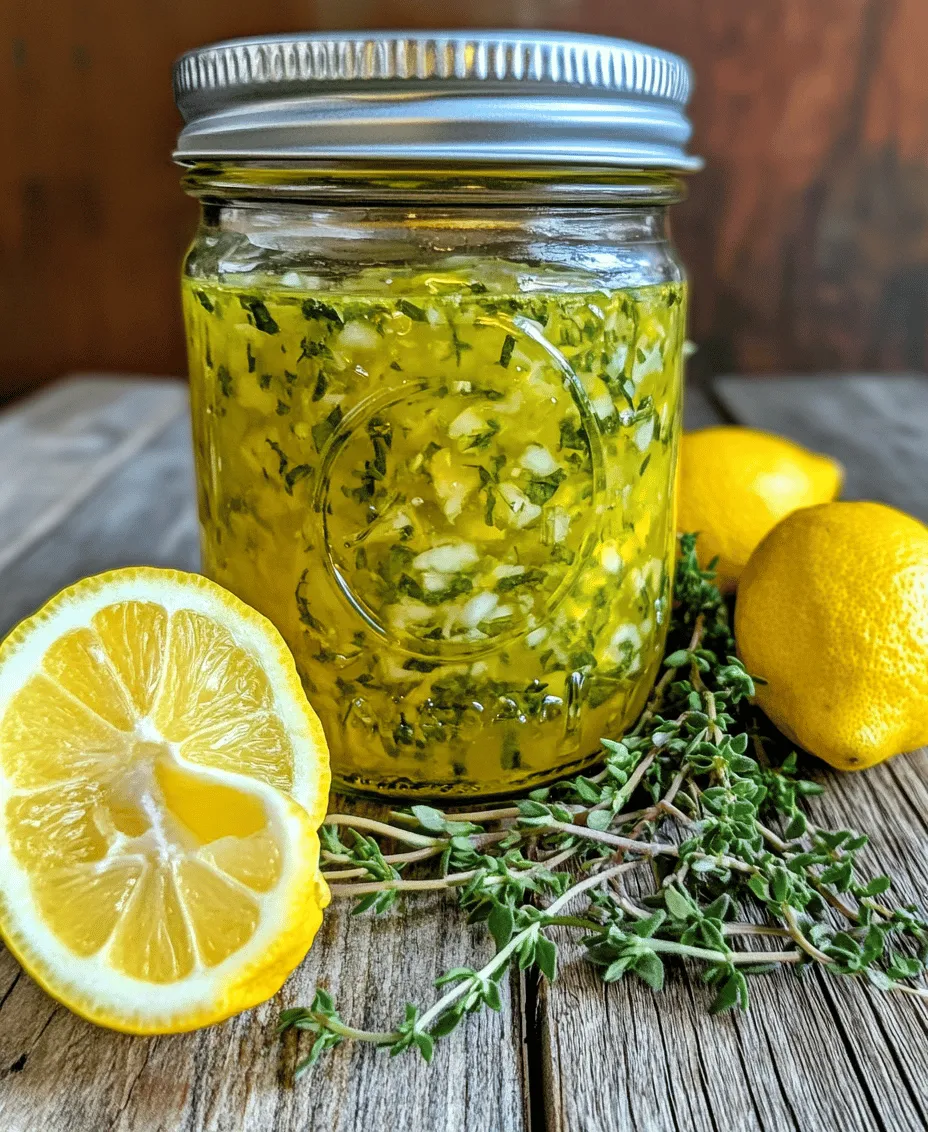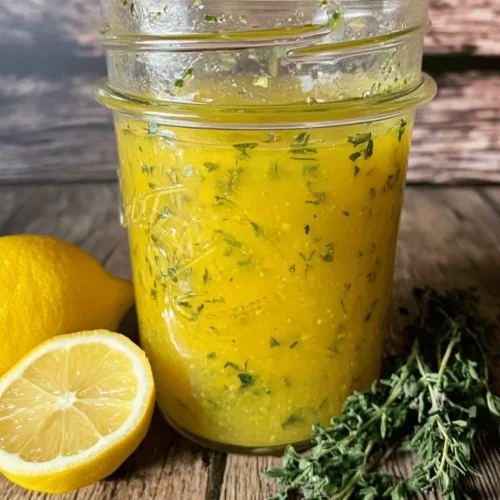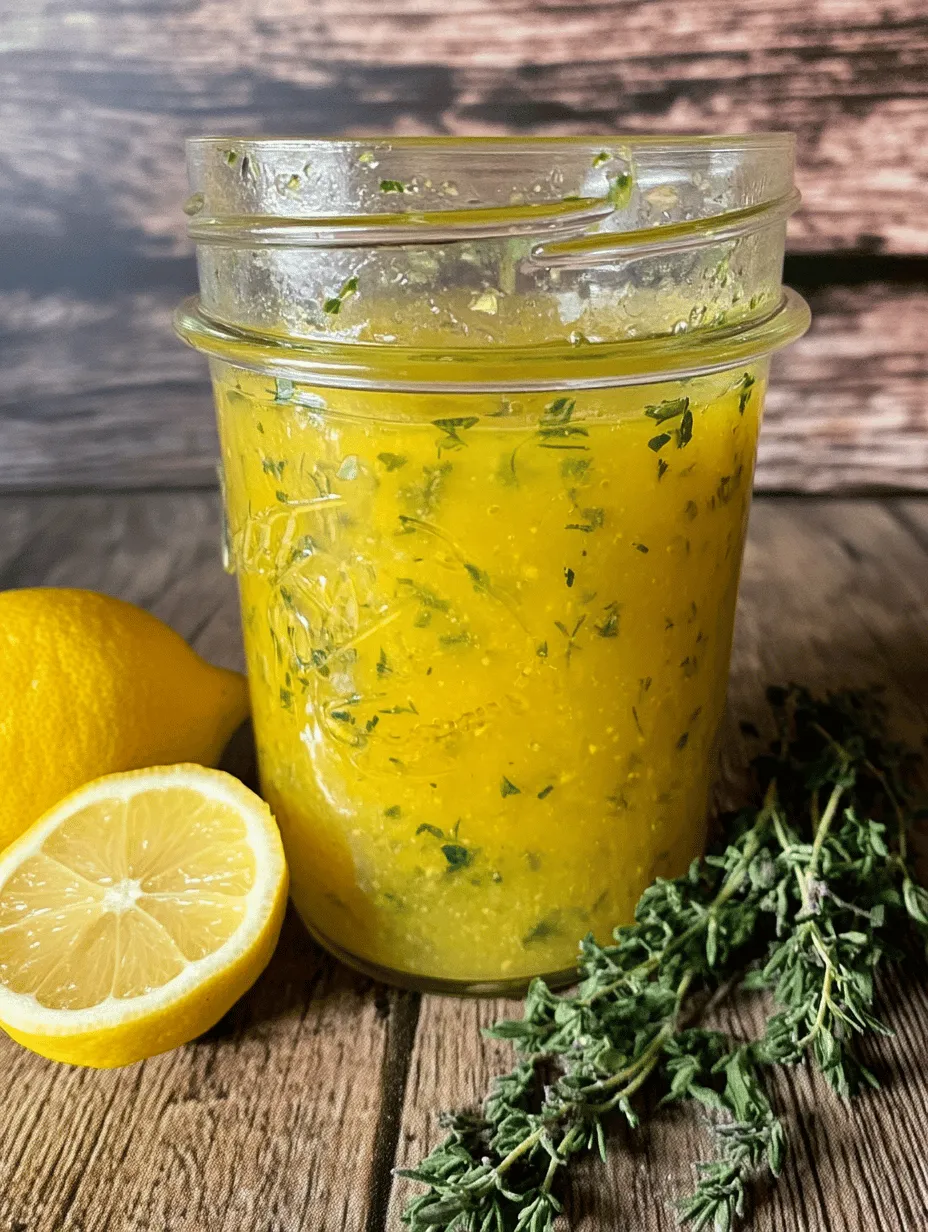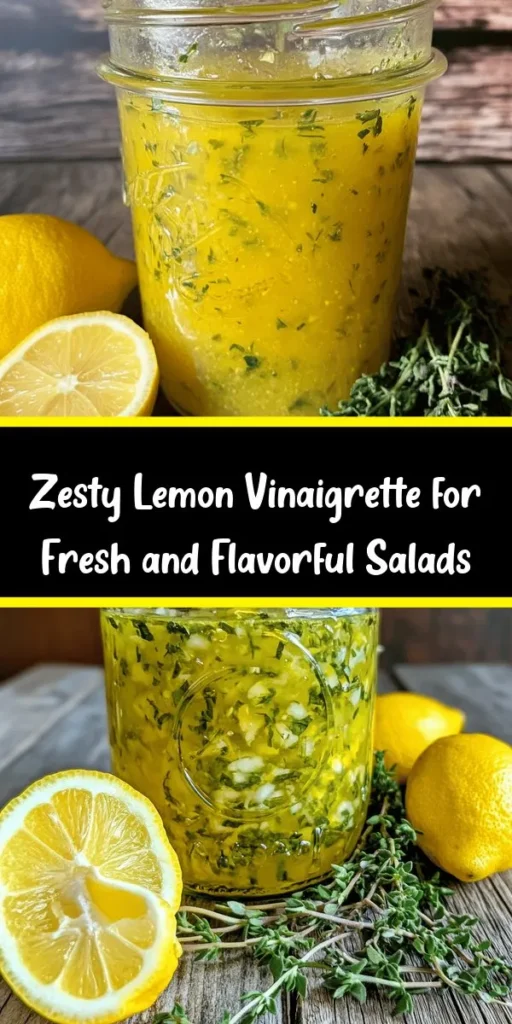Introduction to Zesty Lemon Vinaigrette Delight
In the world of culinary arts, the importance of a good salad dressing cannot be overstated. A well-crafted dressing has the power to elevate any meal, transforming a simple salad into a vibrant dish bursting with flavors. Among the myriad of options available, the Zesty Lemon Vinaigrette stands out as a favorite for its bright, refreshing taste and incredible versatility. This delightful dressing not only enhances salads but also complements grilled vegetables, fish, and even works as an invigorating marinade for meats and tofu.
In this article, we will delve into the origins and benefits of lemon vinaigrette, explore its versatility in various dishes, and provide a detailed, step-by-step preparation guide for this simple yet delicious dressing. As we embark on this culinary journey, you’ll discover how to make a vinaigrette that not only tantalizes the taste buds but also supports a healthy lifestyle.
The Appeal of Vinaigrettes
Exploring the Versatility of Vinaigrettes
Vinaigrettes are an essential component of many cuisines around the world, celebrated for their ability to enhance a wide array of dishes. The beauty of vinaigrette lies in its adaptability; it can be drizzled over fresh greens, tossed with roasted vegetables, or even used as a zesty marinade for proteins. The fundamental components of vinaigrette—acid and oil—play a crucial role in balancing flavors and enhancing the overall taste of a dish.
Acidity, typically derived from vinegar or citrus juice, provides a bright contrast to the richness of oil, creating a harmonious blend that awakens the palate. In the case of our Zesty Lemon Vinaigrette, fresh lemon juice serves as the star ingredient, imparting a refreshing tang that cuts through the heaviness of salads and grilled items alike. This balance of flavors not only delights the senses but also encourages a greater appreciation of fresh ingredients.
Health Benefits of Lemon Vinaigrette
Beyond its delicious flavor, lemon vinaigrette offers a wealth of health benefits. Lemon juice is packed with vitamin C, a powerful antioxidant that supports the immune system and promotes healthy skin. Additionally, the citric acid found in lemons aids digestion and may help prevent kidney stones.
Extra-virgin olive oil, the foundation of many vinaigrettes, is renowned for its health properties. Rich in monounsaturated fats, it can help reduce inflammation and lower the risk of heart disease. Furthermore, this type of olive oil contains antioxidants, which contribute to overall well-being.
One of the most appealing aspects of homemade dressings, including our zesty lemon vinaigrette, is the control it offers over ingredients. Unlike store-bought options, which often contain preservatives and added sugars, a homemade vinaigrette allows you to choose high-quality, fresh ingredients that align with your health goals. This not only ensures a fresher taste but also supports a healthier lifestyle.
Ingredients Breakdown
Crafting the perfect Zesty Lemon Vinaigrette requires a handful of simple ingredients, each contributing to the dressing’s unique flavor. Let’s break down the key components that make this vinaigrette truly delightful.
Fresh Lemon Juice: A Key Ingredient
At the heart of our vinaigrette lies fresh lemon juice. Using freshly squeezed lemon juice elevates the flavor profile significantly compared to bottled varieties. The bright acidity and aromatic qualities of fresh lemons provide a vibrant backdrop for the other ingredients, creating a refreshing balance.
When selecting lemons, look for firm, heavy fruits with a smooth, glossy skin. These lemons are typically juicier and more flavorful. Additionally, the acidity of lemon juice helps to balance the richness of the olive oil, creating a vinaigrette that enhances rather than overwhelms the dishes it accompanies.
Extra-Virgin Olive Oil: The Foundation
Extra-virgin olive oil serves as the foundation for our Zesty Lemon Vinaigrette. Known for its robust flavor and numerous health benefits, this high-quality oil adds depth and richness to the dressing. It is rich in antioxidants and healthy fats, making it a staple in Mediterranean diets and a key component of heart-healthy eating.
When selecting olive oil, opt for extra-virgin varieties that are cold-pressed, as these retain the most nutrients and flavor. Look for oils that are stored in dark glass bottles to protect them from light and preserve their quality. The flavor can vary widely, so it may be worth trying a few different brands to find one that suits your palate.
Dijon Mustard and Honey: Flavor Enhancers
Dijon mustard is another crucial ingredient in our Zesty Lemon Vinaigrette. Not only does it add a delightful depth of flavor, but it also contributes a creamy texture that helps emulsify the dressing. The sharpness of the mustard balances the acidity of the lemon juice, creating a well-rounded taste.
For those with a sweet tooth, honey can be added to the vinaigrette for a touch of natural sweetness. Honey not only enhances the flavor but also helps to soften the acidity of the lemon juice. If you’re looking for alternatives due to dietary restrictions, maple syrup can serve as a great substitute, providing a similar sweetness without the use of animal products.
Garlic: The Aromatic Touch
Fresh garlic is an aromatic powerhouse that adds layers of flavor to the vinaigrette. The pungent notes of garlic enhance the overall taste, creating a dressing that is bold and inviting. Garlic is not only flavorful but also offers numerous health benefits, including anti-inflammatory properties and potential immune system support.
When using garlic in your vinaigrette, opt for fresh cloves rather than pre-minced varieties. Fresh garlic will provide a more vibrant flavor, and you can adjust the amount to suit your personal taste preferences.
Fresh Herbs: The Optional Flavor Boost
To take your Zesty Lemon Vinaigrette to the next level, consider incorporating fresh herbs. Herbs can add an extra dimension of flavor, making the vinaigrette even more enticing. Popular choices include parsley, basil, cilantro, and chives, each contributing its unique aroma and taste.
When using fresh herbs, it’s best to chop them finely before adding them to the vinaigrette. This helps release their essential oils and flavors, ensuring that every bite is infused with the freshness of the herbs.
—
With this understanding of the ingredients that compose our Zesty Lemon Vinaigrette Delight, you’re well on your way to mastering this refreshing dressing. In the next section, we will guide you through the step-by-step process of preparing this simple yet flavorful vinaigrette, making it easy for you to enhance your meals with a burst of zesty goodness. Stay tuned for the detailed instructions that will help you create your own delicious batch of this versatile dressing!

Step-by-Step Preparation of Zesty Lemon Vinaigrette
Creating a delicious Zesty Lemon Vinaigrette is not only simple but also a delightful way to enhance your salads, grilled vegetables, and other dishes. Follow these detailed steps to ensure that your vinaigrette turns out perfectly every time.
Gathering Your Ingredients
Before diving into the mixing process, it’s essential to gather all your ingredients. Here’s a quick checklist:
– Fresh Lemon Juice: About 1/4 cup, freshly squeezed for the best flavor.
– Dijon Mustard: 1 tablespoon, which adds a nice tanginess.
– Honey: 1 teaspoon, for a hint of sweetness that balances the acidity.
– Garlic: 1 small clove, minced finely to infuse flavor.
– Extra Virgin Olive Oil: 3/4 cup, for a rich and smooth base.
– Salt and Pepper: To taste, enhancing the overall flavor.
– Fresh Herbs: Such as parsley, basil, or chives, finely chopped for added freshness.
Preparation Tips: To streamline your cooking process, measure out all your ingredients in advance. This not only saves time but also ensures that you have everything you need at hand. Use a citrus juicer for the lemons to extract maximum juice efficiently. Mince the garlic finely to avoid any large chunks that could overpower the dressing.
Whisking the Base Ingredients
Now that you have everything ready, it’s time to start mixing the base ingredients. In a medium-sized mixing bowl, combine the freshly squeezed lemon juice, Dijon mustard, honey, and minced garlic.
Instructions:
1. Add the lemon juice, Dijon mustard, and honey to the bowl first.
2. Using a whisk, mix these ingredients together until they are well combined. The honey should dissolve completely into the mixture.
3. Continue to whisk until you achieve a smooth consistency, ensuring that the mustard is evenly distributed.
Emulsification Importance: Whisking is crucial in the vinaigrette-making process as it helps to emulsify the ingredients. This means that you create a stable mixture where the oil and vinegar (or in this case, lemon juice) blend together, which is key to a well-balanced vinaigrette.
Emulsifying with Olive Oil
After whisking the base ingredients, it’s time to incorporate the olive oil. This step is essential for achieving that creamy texture and rich flavor we love in a vinaigrette.
Step-by-Step Guide:
1. While continuously whisking the lemon juice mixture, slowly drizzle in the extra virgin olive oil. Start with just a few drops at a time to begin emulsification.
2. As the mixture starts to thicken, you can gradually increase the amount of olive oil you add while continuing to whisk vigorously.
3. Aim for a smooth, creamy texture; it should look somewhat glossy and cohesive without any separation.
Texture to Look For: A well-emulsified vinaigrette should appear thick enough to coat the back of a spoon. If you find that your vinaigrette is too thin, you may not have whisked in enough oil, or you may need to adjust your ratios slightly.
Seasoning to Taste
Once you’ve successfully emulsified your vinaigrette, it’s time to season it. This step is vital, as salt and pepper will enhance the overall flavor profile.
Instructions:
1. Sprinkle salt and freshly ground black pepper into the vinaigrette, starting with about 1/4 teaspoon of each.
2. Whisk to combine and taste. Adjust the seasoning as needed, adding more salt or pepper according to your preference.
Personal Adjustments: Remember that personal taste varies; some may prefer a saltier dressing while others might lean toward a more pronounced lemon flavor. Don’t hesitate to experiment until you find the perfect balance that suits your palate.
Incorporating Fresh Herbs
For an added layer of flavor and visual appeal, fold in fresh herbs at the end of your vinaigrette preparation.
Instructions:
1. Choose your herbs—fresh parsley, basil, or chives work beautifully with this vinaigrette. Finely chop about 2 tablespoons of your chosen herbs.
2. Gently fold the herbs into the vinaigrette. Using a spatula or wooden spoon, incorporate them without overmixing, as you want to maintain their fresh appearance and flavor.
Visual Appeal: The vibrant colors of the fresh herbs not only enhance the taste but also elevate the aesthetic of your vinaigrette, making it an enticing addition to any dish.
Storing and Serving Suggestions
Once your Zesty Lemon Vinaigrette is ready, proper storage will ensure it stays fresh and flavorful.
Best Practices for Storage
To store your homemade vinaigrette, follow these simple tips:
– Container: Pour the vinaigrette into a clean glass jar or airtight container. This helps preserve the flavors and prevents any unwanted odors from other foods in your fridge.
– Refrigeration: Store the vinaigrette in the refrigerator, where it can stay fresh for about one week.
Shelf Life: As a general rule, homemade vinaigrettes can last up to one week in the fridge, due to the freshness of the ingredients used. If you notice any changes in smell or appearance, it’s best to discard the vinaigrette.
Serving Ideas
The versatility of Zesty Lemon Vinaigrette makes it a fantastic addition to various dishes. Here are some creative ways to use it:
1. Salad Dressing: Drizzle over mixed greens, kale, or spinach salads for a refreshing kick. It pairs well with ingredients like avocado, cherry tomatoes, and nuts.
2. Marinade: Use it as a marinade for chicken, fish, or tofu. The acidity from the lemon juice helps tenderize proteins while infusing flavor.
3. Grain Bowls: Toss it into grain bowls featuring quinoa, farro, or brown rice along with roasted vegetables and feta cheese.
4. Grilled Vegetables: Brush it on grilled vegetables for an extra burst of flavor. Zucchini, bell peppers, and asparagus all shine with this vinaigrette.
5. Pasta Salad: Add it to cold pasta salads for a zesty finish that complements the other flavors.
Complementing Ingredients: The Zesty Lemon Vinaigrette pairs wonderfully with Mediterranean ingredients like olives, feta cheese, and sun-dried tomatoes. It also complements Asian-inspired dishes with flavors like sesame and ginger.
Conclusion: The Joy of Homemade Vinaigrette
Making your own Zesty Lemon Vinaigrette is not only an easy and rewarding process, but it also opens up a world of flavor possibilities that store-bought dressings simply cannot match. This homemade dressing is a perfect example of how simple ingredients can create something truly delightful.
By taking the time to craft your own vinaigrette, you gain control over the flavors and ingredients, allowing you to tailor it to your specific tastes and dietary needs. The health benefits of using fresh, wholesome ingredients are an added plus, making it a guilt-free indulgence.
As you experiment with this Zesty Lemon Vinaigrette, feel free to play around with different herbs, add spices, or adjust the sweetness to create your signature dressing. The kitchen is your canvas, and every batch can be a new creation. Embrace the simplicity and joy of homemade vinaigrettes, and elevate your meals with this delightful dressing that’s sure to impress family and friends alike.



